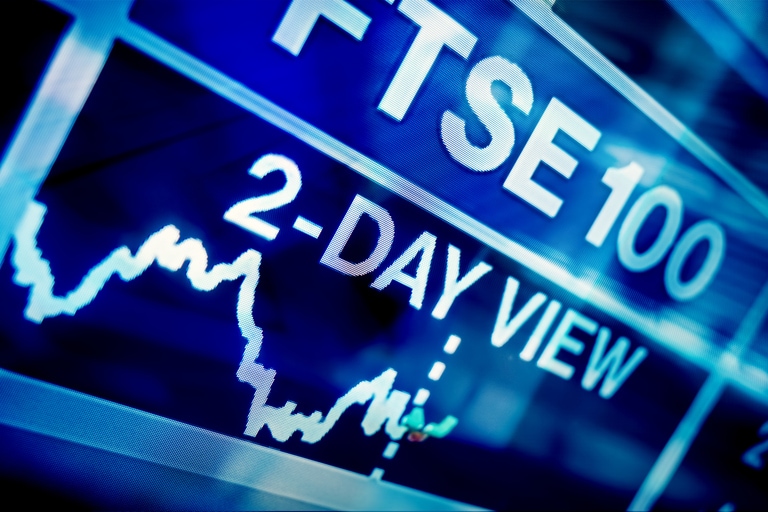Notable economic events this week include the release of minutes from the US Federal Reserve’s September meeting, the US CPI inflation reading for September, and UK unemployment and earnings data. In company updates, look out for the latest earnings from easyJet and US banking giants Citigroup, JPMorgan Chase and Wells Fargo.
OUR TOP THREE EVENTS FOR 10-14 OCTOBER:
Wednesday – US Federal Reserve minutes
The most recent Federal Reserve meeting saw the US central bank hike rates by 75bps, pushing the Fed funds rate up to 3%-3.25%. This pushed the US dollar to a new 20-year high, sending the 2-year yield above 4% for the first time since 2007. Since then, both the US dollar as well as US rates have continued to make new multi-year highs.
The Fed also set out new projections for the benchmark rate, raising the average to 4.4% by the end of this year, up to 4.6% in 2023, before falling to 3.9% in 2024. Fed chair Jay Powell went on to reiterate that the FOMC were “strongly committed” to driving inflation lower, while signalling that more rate rises are on the way. Powell added that there was no painless way to drive inflation lower, with the prospect that we could see another 125bps added to the current rate by the end of this year, starting with 75bps at the November meeting.
The US central bank seems completely relaxed about the effect its monetary policy is having on the rest of the world, even as it expects US GDP to slow to 0.2% in 2022, with Powell admitting that a recession might be possible. Core inflation is forecast to decline to 4.5% this year, before falling to 2.1% by 2025.
This week’s minutes are likely to offer an insight into whether there is any unease among some Fed policymakers as to the side effects the Fed’s current policy stance more globally. There is already evidence that inflation is starting to fall back of its own accord, as lower demand prompts a tempering of prices, although core prices are proving to be slightly stickier. To date there has been little acknowledgement of the effect the surging US dollar might be having as well, particularly when it comes to the effects on US companies.
Thursday – US CPI inflation (September)
Fears over US inflation stepped up a notch in August, despite the headline consumer price index (CPI) rate slipping back to 8.3% from 8.5%. The resulting market reaction saw the US dollar continue to push higher because investors had been expecting a bigger decline to 8%, while core prices rose sharply from 5.9% to 6.3%, a bigger-than-expected increase. This rise in core prices suggests that inflation is likely to be much stickier over the next few months than markets had originally been hoping, thus adding to the risk we could see the Federal Reserve not only be much more aggressive on rate hikes but keep those rates higher for longer.
It’s certainly not a number that Fed officials are going to be happy with, and will merely serve to reinforce Powell’s message that the Fed will keep at it until there is clear evidence that inflation is on a sustainable downward path. With the US dollar continuing to look worryingly strong, and yields globally continuing to rise sharply, markets will be looking for any signs of a respite with the prospect of a softer number.
On the plus side, energy prices have continued to slip back, which is good news from a consumer point of view, however with businesses now biting the bullet and pushing prices up, any hopes of a respite look quite some way off. Core prices now appear to be the main focus here, with less emphasis on the headline CPI rate, which should continue to come down.
Thursday – easyJet Q4 results
With easyJet’s share price at 10-year lows, the airline has had a poor year in this regard. Not only has the company had to contend with bid speculation from the likes of Wizz Air, but it’s also had to deal with surging energy prices, as well as large-scale travel disruption throughout the summer, as airports have struggled to cope with surging passenger numbers.
In Q3, the airline posted a headline loss before tax of £114m, with the impact of the summer disruption setting it back £133m The number of passengers flown rose to 22m, with 87% of 2019 capacity during the quarter, compared to 16% a year ago. This is expected to increase to 90% in Q4. Total group revenue for Q3 increased to £1.75bn, with ancillary revenues increasing to £603m as more passengers paid extra for items like speedy boarding and extra cabin bags. Costs were also higher, rising to £1.87bn. Fuel costs for Q4 were 83% hedged, and 60% hedged for the first half of fiscal year 2023, at $784 per metric tonne.
KEY EVENTS OVERVIEW (10-14 OCTOBER):
Monday 10 October
No major annnouncements
Tuesday 11 October
UK earnings, unemployment (August)
While all the headlines are about the impact of rising energy prices and the cost-of-living crisis, one silver lining is that UK unemployment fell to its lowest level since 1974 back in July, to 3.6%. At the same time, average earnings including bonuses ticked back up to 5.5%. More disappointingly, the fall in unemployment also coincided with a rise in the number of people who are long-term sick, which rose to 21.7% and a six-year high. Vacancy rates nonetheless remained high, despite falling by a modest 34,000 to 1.3m, which means wage growth is unlikely to slow significantly in the short term.
The real battle remains against inflation, which fell to 9.9% in August, however the sharp decline in the pound in the past month against the US dollar has done enormous damage to that battle, given that we were at 1.1600 this time a month ago, and are now well below that. However decent these wages and unemployment numbers are, the real battle remains against inflation, a battle the Bank of England, and the UK government, is currently losing.
Wednesday 12 October
US Federal Reserve minutes
See top three events, above
Thursday 13 October
US CPI inflation (September), easyJet Q4 results
See top three events, above
Friday 14 October
China trade balance (September)
With the rolling lockdowns that took place during August across the whole of China, it wasn’t surprising that the resultant trade numbers were somewhat disappointing. Imports data had already been weak for several months, rising 2.3% in July, up from 1% in June. The numbers in August reinforced a continued lack of confidence on the part of the Chinese consumer, as well as a lack of demand, slowing to a weaker 0.3%, well below expectations of 1.1%.
Exports data has generally been the better of the two data points. We saw a strong performance in July with a rise of 18%, beating expectations after a weak Q2, and helping to push the trade surplus ever higher. However, this improvement proved short-lived, with a sharp slowdown in August to 7.1%, well below expectations of 13%.
As we look ahead to the latest September data, Chinese authorities are taking various measures to try and help the economy, apart from the one that could make all the difference – relaxing the zero-Covid policy.
Citigroup Q3 results
One of the more notable takeaways from Citigroup’s Q2 numbers was a positive reaction from investors, as CEO Jane Fraser continued with her restructuring plan for this giant of the US banking system. Q2 revenue beat expectations at $19.6bn, while profit came in well ahead of forecasts, at $2.19 a share. FICC trading revenue came in much better-than-expected, at over $4.08bn, raising the question as to whether forecasts were set too low. It's always easier to beat a low bar, with most of the outperformance coming from rates, currencies, and commodities trading.
Investment banking revenue came in short, like its peers, at $805m, while the bank looks to extricate itself from its deeper ties in Russia, with losses there expected to be slightly lower, at about $2bn in a worst-case scenario. This would be a relief, with some scenarios suggesting up to $3bn in losses. The bank set aside $1.3bn in respect of provisions for credit losses, although like its peers, credit card lending rose, as did demand for ordinary loans. Investors will be looking for additional signs of consumer stress when it comes to the outlook for Q4, with Q3 profit expected to come in at $1.55 a share.
JPMorgan Chase Q3 results
Despite sharply rising interest rates, US banks have been on a one-way ticket to Downsville this year, and although they aren’t the worst performers on the S&P 500 this year, the sector is still down over 30% year to date. Concerns about a recession by year end have been steadily increasing, in the face of a US central bank determined to drive down inflation, even if it means pushing up unemployment.
We’re already seeing the rising cost of living starting to impact consumer spending in the face of rising energy and food prices. Declining house prices have also weighed on consumer sentiment, as has soaring mortgage rates. While the US consumer has proved resilient so far, this deterioration in the economic outlook is likely to manifest itself into lower demand for banking services from business and consumers.
A strongly inverted yield curve isn’t helping banks this quarter either. At JPMorgan’s last set of numbers for Q2, revenue of $31.63bn came in below expectations at $31.97bn, while profit also fell short at $2.76 a share, with the bank announcing the temporary suspension of its buyback programme, as it looked to shore up its balance sheet against the looming storm clouds. JPMorgan set aside another $1.1bn in respect of provision for credit losses, on top of the $1.5bn in Q1, even as credit and debit card spending rose by 15% during the quarter. The fact that less than a year after returning capital to shareholders from loan loss reserves, the bank is now rebuilding those reserves, should be a cause for concern as to how it sees the rest of the year playing out.
Friday's Q3 results could reinforce those concerns. Loans in Q2 rose by $1.1tn, which was more than expected, while it was notable that Q2 FICC sales and trading revenue came in short at $4.71bn. Investment banking revenue was also lower than forecast, for the second quarter in a row, with a sharp drop off in fees due to lower M&A and other advisory activity. This could also be repeated for Q3. Profit is expected to come in at $2.91 a share.
Wells Fargo Q3 results
Wells Fargo is probably the best bellwether of the US economy given its smaller investment banking operation, and bigger focus on the US mortgage, savings, and loans market. In its Q2 numbers, there were already early indications that US consumers were feeling the effects of the rising cost of living, along with higher US mortgage rates.
Q2 revenue came in at $17.03bn, below expectations with underperformance across all of its main businesses. The bank set aside a larger than expected $580m in respect of credit losses, saying it expects these to increase further. Its investment banking operation also saw a $107m writedown. Mortgage lending also dropped heavily to $287m, from $1.3bn in Q1, giving a stark illustration of how much damage higher interest rates have done to consumer demand for housing.
This is unlikely to have improved in Q3 given that US mortgage rates have risen to 20-year highs in the past few weeks. Ordinary loans did see an increase, rising to $926.6m, driven by personal and auto loans, but even here we could start to see a slowdown, given recent moves in bond markets. Q3 profit is expected to come in at $1.09 a share.
INDEX DIVIDEND SCHEDULE
Dividend payments from an index's constituent shares can affect your trading account. View this week's index dividend schedule.
SELECTED COMPANY RESULTS
| MONDAY 10 OCTOBER | |
| No major announcements | |
| TUESDAY 11 OCTOBER | RESULTS |
| E2open Parent Holdings (US) | Q2 |
| WEDNESDAY 12 OCTOBER | RESULTS |
| Duck Creek Technologies (US) | Q4 |
| PepsiCo (US) | Q3 |
| THURSDAY 13 OCTOBER | RESULTS |
| easyJet (UK) | Q4 |
| Fastenal (US) | Q3 |
| Oil-Dri Corporation of America (US) | Q4 |
| Walgreens Boots Alliance (US) | Q4 |
| FRIDAY 14 OCTOBER | RESULTS |
| Citigroup (US) | Q3 |
| JPMorgan Chase & Co (US) | Q3 |
| Morgan Stanley (US) | Q3 |
| PNC Financial Services Group (US) | Q3 |
| UnitedHealth Group (US) | Q3 |
| US Bancorp (US) | Q3 |
| Wells Fargo & Co (US) | Q3 |
Company announcements are subject to change. All the events listed above were correct at the time of writing.
CMC Markets erbjuder sin tjänst som ”execution only”. Detta material (antingen uttryckt eller inte) är endast för allmän information och tar inte hänsyn till dina personliga omständigheter eller mål. Ingenting i detta material är (eller bör anses vara) finansiella, investeringar eller andra råd som beroende bör läggas på. Inget yttrande i materialet utgör en rekommendation från CMC Markets eller författaren om en viss investering, säkerhet, transaktion eller investeringsstrategi. Detta innehåll har inte skapats i enlighet med de regler som finns för oberoende investeringsrådgivning. Även om vi inte uttryckligen hindras från att handla innan vi har tillhandhållit detta innehåll försöker vi inte dra nytta av det innan det sprids.






